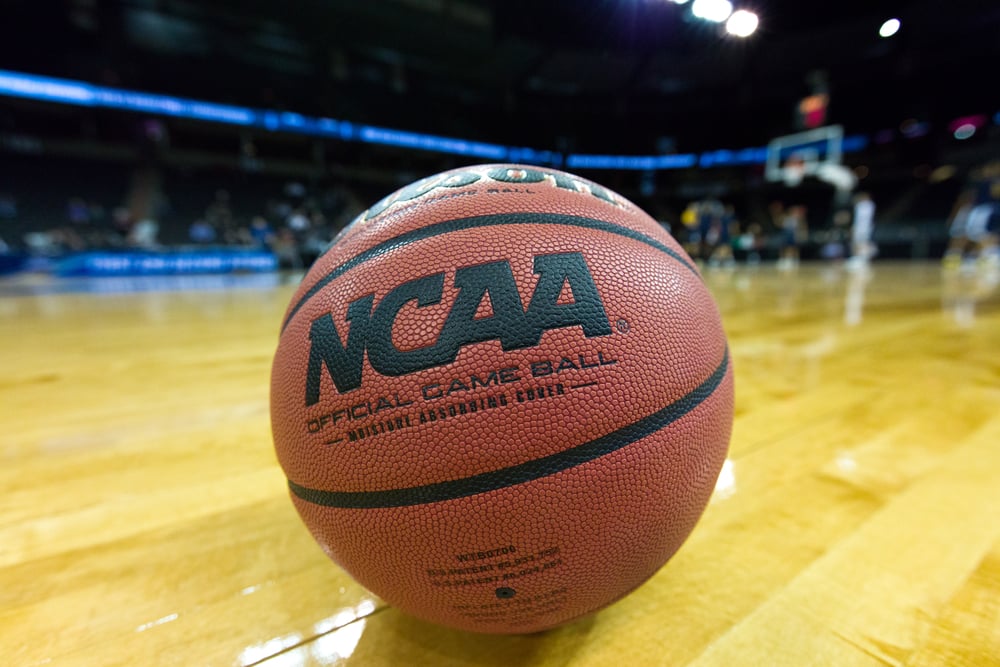Quick Highlights:
- College athletes generate significant revenue for institutions, yet they often aren’t paid.
- According to US News and World Report, under 2% of all undergraduate students receive any type of athletic scholarship.
- Arguments against paying athletes include concerns about maintaining amateur status and the logistical challenges of fair compensation.
- There are also legal aspects, like Title IX implications and recent changes allowing athletes to profit from their name, image, and likeness.
Should college athletes be paid? It’s a thorny decision full of complexities and potential pitfalls, and the issue has only become more prominent in recent years.
Read on for our breakdown of the pros and cons of paying college students for sports.
Related Resource: Colleges With Full Ride Scholarships
Reasons Why College Athletes Should be Paid

The underlying principle behind most of the arguments for paying college athletes is simple and widely accepted. People should be paid for their labor and the value it brings to organizations.
1. College athletes generate billions of dollars per year for schools, media outlets, and corporate sponsors.
College sports programs raked in $14 billion in revenue in 2019, according to the Department of Education. That number has risen sharply since 2003, when it amounted to $4 billion, according to the report “Madness Inc.: How Everyone is Getting Rich Off College Sports—Except the Players” by U.S. Senator Chris Murphy of Connecticut. Keep in mind that this figure doesn’t even count the money that earned by:
- corporate sponsors
- apparel companies
- broadcasters
Many different entities earn money off the hard work of the college athletes who, themselves, aren’t earning anything.
The fruits of student-athletes’ labor on the field, court, or track are clear. Everyone else is benefitting, so why shouldn’t the students themselves get more out of their efforts in college athletics?
2. There’s not enough time for school, sports, and a job, and college athletes need to support themselves.
College athletes spend an “insane” amount of time practicing and training for their sport, according to Business Insider. Despite restrictions by the National Collegiate Athletic Association (NCAA) limiting official in-season practice sessions to a total of 20 hours per week, student-athletes spend a significant amount of time on the field. Athletes have reported spending an average of 30, 40, and even 45 hours on athletics in multiple studies conducted over multiple years, Business Insider reported.
For some student-athletes, “playing” an unpaid sport is the equivalent of working a full-time job.
There’s nowhere near enough time in the day for student-athletes to balance these demands and:
- focus on their studies
- train to their full potential as athletes
- juggle a job
Yet without being paid for their work as athletes, these students will struggle to support themselves. Student-athletes who come from low-income families need to earn money to pay for their own living expenses. Some of them are also expected to contribute to the household financially.
Is it fair for student-athletes to struggle as “poor college kids” while they bring billions of dollars of revenue into their schools?
3. Student-athletes run the risk of getting an injury that could permanently affect their lives.

College athletes should be paid because playing sports has its risks. Should athletes taking these risks should see a greater reward?
Imagine that a college athlete is on track to be recruited to a professional sports team and earning millions of dollars per year—until a career-ending injury on the field rips away their dreams of playing professionally. This is the risk athletes take each time they set foot on the field.
An injury at the college level could keep athletes from making it to the professional leagues. Realistically, most athletes won’t reach pro status, anyway. Fewer than 2% of athletes go on to play professionally, according to the NCAA. However, just because they won’t earn a living by playing sports doesn’t mean these old sports injuries won’t continue to affect their lives long after graduation.
4. Contrary to popular belief, most college athletes don’t receive full scholarships.

Sports scholarships aren’t as widely distributed or as generous as people often believe. Although Division I and Division II schools award $3.6 billion in athletic scholarships to more than 180,000 students per year. That translates to only 1% to 2% of undergraduate students in America, according to U.S. News & World Report.
Even students who manage to get athletic scholarships rarely get a “full ride.” The average sports scholarship amount is $18,000. This figure is less than the average out-of-state cost of tuition and fees even at public universities, according to U.S. News & World Report. College athletes are often on their own for:
- room and board
- textbooks
- living expenses
Reasons for Not Paying Student Athletes
Why should college athletes be paid? Opponents have made a number of arguments—some stronger than others—about the fairness and logistics of compensation for college athletes.
1. College athletes already receive compensation in the form of scholarships.
This is probably the weakest argument for not paying athletes who play college sports. The impact of these scholarships is exaggerated, as we’ve already established.
ProCon/Encyclopaedia Britannica, Inc. reported that if college athletes earned salaries at 50% of the team’s revenue—the equivalent rate of professional players in the NFL and the NBA—the average college football player would make $360,000 per year. The average college basketball player would make $500,000. Clearly, that average $18,000 scholarship amount doesn’t come close to fully compensating college athletes.
2. Navigating Title IX could become more complicated than ever if college athletes were paid.

Title IX of the Education Amendments of 1972 is the federal civil rights law that “protects people from discrimination based on sex in education programs or activities that receive federal financial assistance,” the U.S. Department of Education reported. Under Title IX, colleges and universities have to provide equal opportunities for male and female student-athletes.
Should college athletes be paid equally? If college athletes were compensated, how would schools handle paying athletes of different sexes and genders? Would male and female athletes earn the same amount, or would they only be guaranteed the same number of salaries available for athletes, or will Title IX mean something else entirely in this context? Should D1 athletes get paid more than athletes at a DII or DIII school?
It’s a tough question but needing to answer that question isn’t a solid reason for not paying these athletes.
3. The decision to pay college athletes raises a lot of questions about who should and would get paid, how to pay student-athletes fairly, and where the money would come from.
Aside from navigating how to avoid sex discrimination in paying college athletes, there are questions about how to make compensation fair for all athletes. For example, would all players on the college football team earn the same salary, or should the quarterback earn more—and if so, how much more should athletes be paid?
Who would be on the hook for paying these athletes? Should student athletes be paid based on how much revenue their sport brings in? College athletic programs bring in a lot of money for the school, but where does that money go? In some cases, it’s used to pay bloated salaries to:
- coaches
- athletic directors
- administrators
However, in other instances, that money is used to support school initiatives or pet projects. In some cases, schools have invested in new facilities and academic programs and offered other sports and extracurricular activities that weren’t lucrative for the school.
If the money currently being brought in by collegiate sports is diverted to paying athletes, the budget for other items must be cut. The question is what cuts could be made without hindering academic and research growth or reducing other opportunities for students?
4. A college sports model that requires student-athletes to be paid could lead to cuts in other sports and activities.
Should colleges pay their athletes if that meant sacrificing other extracurriculars? In the real world, if colleges had to pay all athletes, they would likely end up cutting sports programs that don’t bring in enough money. Some colleges sports athletes would benefit, but many others would lose out on opportunities.
5. Paying college athletes takes away from the fundamental difference between amateur and professional athletes.
Former collegiate athletes like Tim Tebow have weighted on the question should college athletes get paid. He believes that college should be about pursing your dreams and contributing to the college or university. The focus shouldn’t be on making money. College sports would become like professional sports in that schools offering the most money to their players would attract the best players. Schools with bigger budgets would be able to afford better players.
Public Opinion on Paying College Athletes
There are strong opinions on all sides of the debate about paying athletes. A (slight) majority of Americans support college athlete compensation.
Among Americans in general, 51% supported paying college athletes in 2020, according to a study by Ohio State University. In 2019, a combined 53% of students favored or strongly favored paying college athletes a salary, according to CNBC.
Compliance With Laws, Regulations, and NCAA Policies

One complication to paying college sports athletes is figuring out how these policies would work in relation to other regulations (not limited to Title IX).
The NCAA has historically limited eligibility to athletes who have never been paid to compete in a sport. NCAA policies would have to change drastically for compensation for college athletes to become the norm. The NCAA has even sought to limit educational benefits that can be offered to athletes who receive scholarships, according to NPR. A Supreme Court NCAA ruling in June 2021 agreed with students’ assertions that these restrictions violated antitrust law.
Laws and regulations can be changed. In fact, many of the relevant laws and policies have changed in recent years. For example, on July 30, 2021, the NCAA adopted an interim name, image and likeness policy that allowed college sports athletes to be compensated for the use of their personal brand.
At the state level, California lawmakers introduced The Fair Pay to Play Act in 2019. Dozens of additional states had passed or at least introduced similar name, image, and likeness laws by July 2021, according to ProCon/Encyclopaedia Britannica, Inc.
According to the National Conference of State Legislatures, in 2021, multiple federal bills relating to student-athlete compensation were introduced in Congress. These include:
- Student-Athlete Level Playing Field Act
- College Athlete Economic Freedom Act
- Amateur Athletes Protection and Compensation Act of 2021
Generally, these federal laws have focused more on the right to compensation for the use of the student’s name, image, and likeness than for direct salaries for playing college sports.
Conclusion
As with any complex issue, the compensation of college athletes is a nuanced debate.
Why should college athletes be paid? Pros and cons of paying athletes exist, but the majority of Americans and college students support compensation for student-athletes.
Related Articles:
Top Online Master’s Programs in Sports Medicine and Physical Therapy
Best Master’s Degrees in Sports Medicine Online
Top Sports Management Online Masters Degree Programs